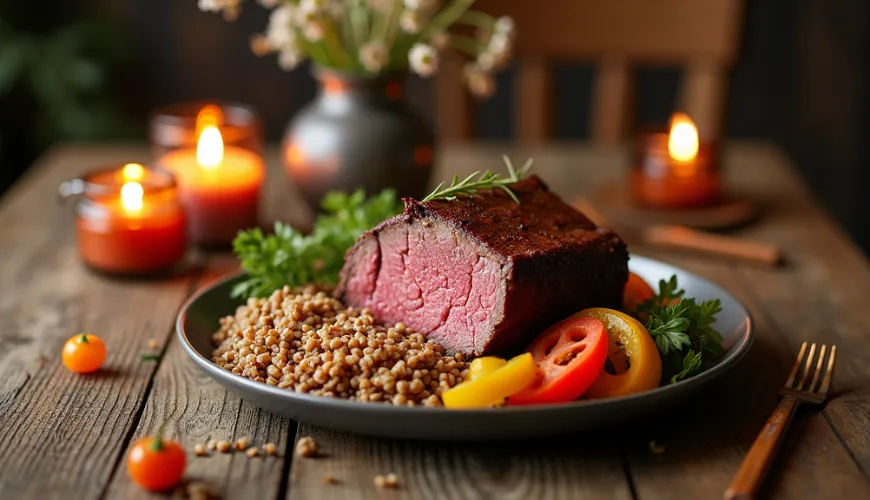
Discover the Magic of Štěpánská Beef Roast and Its Easy Preparation

Štěpánská Beef Roast - A Classic of Czech Cuisine
When you think of Czech cuisine, most people imagine svíčková, guláš, or knedlo vepřo zelo. But there are many dishes that deserve the same recognition, and one of them is Štěpánská beef roast. A traditional dish with a rich history and unmistakable flavor, it combines the best of sauces, well-prepared meat, and side dishes like rice or boiled potatoes. Among Czech recipes, it might not be as well-known as other classics, but once you taste it, you will fall in love.
What Does "Štěpánská" Roast Mean?
The origin of the name is not entirely clear, but it is most commonly associated with the Christmas period – specifically with the feast of St. Stephen, celebrated on December 26th. Traditionally, "Štěpánská" meals were served on this day, usually made from leftover meat from the Christmas feast, supplemented with new ingredients to create a new dish. Štěpánská beef roast was often made from meat leftover from the Christmas Eve dinner, creating something truly exceptional.
Today, however, this recipe is cooked all year round. Its popularity is growing, not only because of its full flavor but also its easy preparation. Štěpánská beef roast is similar to tomato or dill sauce, but instead of sweet or sour flavors, it features a mildly spicy tomato sauce with pickled vegetables. The result is a balanced and nutritious meal that satisfies while delighting the taste buds.
What Makes Štěpánská Roast So Special?
The key to success lies in quality meat. Most commonly, beef thigh or shoulder is used, which is slowly roasted until the meat is tender, juicy, and falls apart at the touch of a fork. To this, pickled vegetables are added, usually cucumbers, peppers, and celery, giving the meat freshness and a pleasant acidity. The sauce is made from a tomato base, but it is not as sweet as the classic tomato sauce.
The delicate balance between acidity, spiciness, and meaty flavor is complemented by rice, which is the most common side dish. And it's no coincidence – rice perfectly absorbs the sauce and creates a perfect whole with the meat. Some prefer bread dumplings, but rice wins with its lightness and versatility.
An experienced cook from South Bohemia, Mrs. Alena, recalls: "We used to make Štěpánská roast for celebrations and holidays. It was a dish that looks simple, but when done well, it tastes like it's from the best restaurant."
Traditional Recipe and New Variations
Although the basic recipe remains the same – roasted beef, pickled vegetables, and tomato sauce – today people love to experiment. Instead of the classic beef shoulder, some use beef neck, which has more fat and is therefore even juicier. Others add a pinch of chili or smoked paprika to the sauce, creating a more modern version.
The traditional recipe is roughly as follows: the meat is first seared with onions, garlic, tomato paste, spices (bay leaf, allspice, pepper, salt), and water or broth. Then pickled vegetables are added to the mixture, and everything is baked in the oven or stewed on the stove until the meat is tender. The sauce is finished with butter and possibly seasoned with vinegar or sugar for flavor balance.
A Healthier Alternative That Doesn't Lose Flavor
While traditional Štěpánská beef roast is quite hearty, today there are also versions suitable for those who pay attention to a healthy lifestyle. Instead of regular oil, one can use rapeseed oil, which has a higher content of omega-3 fatty acids. Instead of classic white rice, one can choose brown rice or quinoa, which contain more fiber and minerals.
The choice of meat can also be leaner – for example, beef rump without fat. Vegetables remain a key element, and when used in organic quality or from home sources, the taste result is even more authentic. Some even replace part of the tomato sauce with pureed roasted peppers, adding a pleasant depth to the dish.
Even vegetarians can adapt this recipe to their liking – instead of meat, they can use tempeh, tofu, or seitan, which is stewed in the tomato-vegetable sauce just like classic meat. The result is a tasty plant-based version that won't offend even staunch meat lovers.
Why Do People Keep Coming Back to It?
It's not just the taste that makes Štěpánská beef roast popular. It's also the feeling of home it brings. Like svíčková or bread with butter and honey, it's a dish that evokes memories – of family lunches, grandma's kitchen, and moments when all the loved ones gathered at the table.
The simplicity of preparation is another advantage. Although the meat is stewed for a relatively long time, the actual kitchen work doesn't take much time. Additionally, it's perfect for preparing a day in advance – it might taste even better the next day as the flavors meld beautifully.
Finally, it's the affordability that makes this dish a sensible choice for any household. From a few basic ingredients, a meal is created that can feed even a large family without breaking the budget.
Inspiration for a New Generation of Cooks
While older generations know Štěpánská beef roast from family cookbooks, for the younger ones it is often a novelty. In an era of international cuisines and exotic recipes, traditional Czech dishes may seem forgotten – but that's precisely why it's time to rediscover them. Many young gastronomy enthusiasts today are returning to traditions and seeking recipes that have history and soul.
When quality ingredients, gentle preparation, and a sense of taste come together in a modern kitchen, a dish emerges that finds its place even on a festive table. And Štěpánská beef roast with rice is a beautiful example of this.
Few dishes can so well combine traditional Czech flavors, simplicity of preparation, and room for personal creativity. Whether you prepare it according to your grandmother's recipe or give it a modern twist, it will always reward you with aroma, taste, and above all – the feeling that home is where it's being served.

